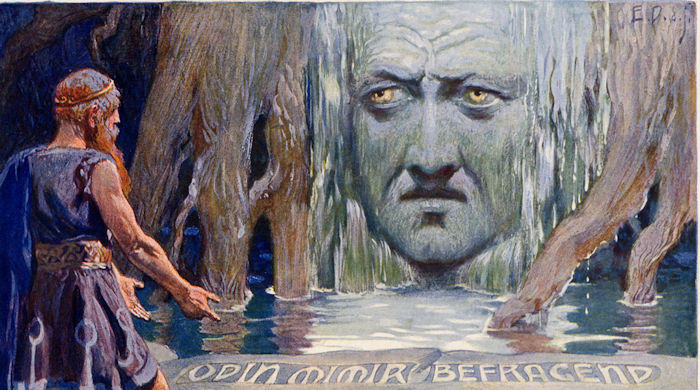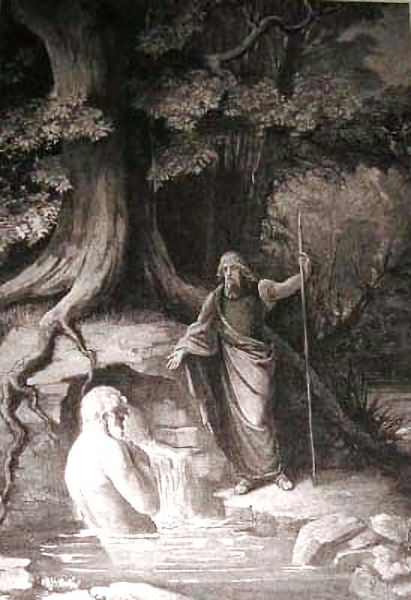Giant Mimir And The Well Of Wisdom In Norse Beliefs
A. Sutherland - AncientPages.com - In Norse mythology, giant Mimir usually appears in the company of Odin, the most powerful and wisest of the gods.
The giant Mimir, however, can easily compete with Odin because he – like the Norns - possesses the wisdom that is not from this world.
Odin Questions Mimir by Carl Emil Doepler, Jr. (1905) Credit: Public Domain
He is the consultant of the gods and knows the secrets of magic runes, and can predict the future. He is the god of knowledge and wisdom and is often called the god of prophecy.
Mimir (in Old Norse: "The Rememberer, The Wise One") is a mysterious figure in Norse beliefs, and it is unclear if he is a god or one of the giants. Three forms of his name are known: Mimi, Mimr, and Mimir, and this name has a strong association with the Latin "memor" – memory, and the Greek: "mermairo" – care.
Mimir is the owner of the Mimir's Well that keeps wisdom and understanding in the world. The well and Mimir's abode are located beneath the second root of Yggdrasil, the World Tree. Mimir guards the well, drinks from it daily, and gains his wisdom from this source. He also feeds Yggdrasil, the sacred tree, daily on the waters from the well.
A Sacrifice In Exchange For A Drink From Mimir's Well
Many visitors come and ask for a drink, but at first, they have to provide a sacrifice of some kind. The god Odin also attempts to access the sacred mead from the well. Mimir is aware of the value of such a favor. He demands a sacrifice in exchange for a drink from the well.
"All right, then I will give you a sip," he says, but it will cost you. The price will be your right eye."
Mimir and Odin by E. Phillip Fleischer (1881). Credit: Public Domain
Whether Odin sacrifices the eye willingly or after some debate is unknown, but in the end, Odin drops his right eye to the well. The eye loss is the price Odin must pay to gain the privilege of drinking from the well.
Why Did Mimir's Head End Up In A Well?
From Norse mythology, we learn that after the war between the Aesir and Vanir, Mimir was sent together with Hoenir to the Vanir gods.
Known as God of Silence and Odin's brother, Hoenir was indecisive and always relied on Mimir to make the decisions. It made the Vanir suspicious and annoyed, so they beheaded Mimir and sent his Head back to Odin and the Aesir.
Odin used his magic to preserve Mimir's Head and often consulted the beheaded god for advice and wisdom. Mimir's Head is the wisest of all heads ever known, but it cannot solve all the problems.
On the day when Fenrir threatens the destruction of the world, the mighty Odin seeks Mimir's advice. Unfortunately, Mimir's Head, the wisest of all heads, cannot help him in this case.
Stories about Mimir are included in the Poetic Edda poems "Völuspá" and "Sigrdrífumál." However, the story about Mimir's Head is narrated only in Snorri Sturluson's "Ynglinga Saga," the first part of "Heimskringla."
Snorri most probably either quoted poems that have not survived in the manuscripts, or he invented this story.
Updated on August 17, 2022
Written by – A. Sutherland AncientPages.com Staff Writer
Copyright © AncientPages.com All rights reserved. This material may not be published, broadcast, rewritten or redistributed in whole or part without the express written permission of AncientPages.com
Expand for referencesReferences:
Brate E. Eddan, De nordiska guda- och hjältesångerna
Baeksted A. Nordiska gudar och hjältar
More From Ancient Pages
-
 Mystery Of The Giant Laos Jars Continues – New Discoveries Reported By Scientists
Archaeology | Apr 19, 2021
Mystery Of The Giant Laos Jars Continues – New Discoveries Reported By Scientists
Archaeology | Apr 19, 2021 -
 King Sanakht: Mysterious Ancient Egyptian Pharaoh Was A ‘Giant’ – Scientists Say
Archaeology | Aug 9, 2017
King Sanakht: Mysterious Ancient Egyptian Pharaoh Was A ‘Giant’ – Scientists Say
Archaeology | Aug 9, 2017 -
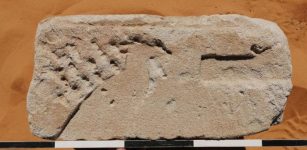 Hieroglyphs Discovered In Sudan’s Old Dongola – Once Important City Of Nubia
Archaeology | Mar 6, 2023
Hieroglyphs Discovered In Sudan’s Old Dongola – Once Important City Of Nubia
Archaeology | Mar 6, 2023 -
 Ancient DNA Reveals Surprising Stories About Migrations And Genetic Mixing Of Our Ancestors
Archaeology | Feb 22, 2018
Ancient DNA Reveals Surprising Stories About Migrations And Genetic Mixing Of Our Ancestors
Archaeology | Feb 22, 2018 -
 Seven Bronze Age Swords And Large Hoard Of Slavic Coins Found In Germany
Archaeology | Dec 4, 2023
Seven Bronze Age Swords And Large Hoard Of Slavic Coins Found In Germany
Archaeology | Dec 4, 2023 -
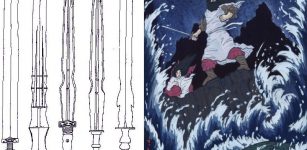 Sacred Regalia Of Japanese Emperor: Sword, Mirror And Jewel In Ancient Japanese Tradition
Artifacts | Sep 2, 2017
Sacred Regalia Of Japanese Emperor: Sword, Mirror And Jewel In Ancient Japanese Tradition
Artifacts | Sep 2, 2017 -
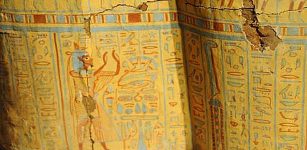 2,700-Year-Old Sarcophagus Of ‘High Priest Of God Amun’ Discovered In Luxor
Archaeology | Nov 27, 2015
2,700-Year-Old Sarcophagus Of ‘High Priest Of God Amun’ Discovered In Luxor
Archaeology | Nov 27, 2015 -
 Tullus Hostilius: Warrior King Of Rome, Who Succeeded Numa Pompilius And Feared Prophecies
Featured Stories | Mar 6, 2019
Tullus Hostilius: Warrior King Of Rome, Who Succeeded Numa Pompilius And Feared Prophecies
Featured Stories | Mar 6, 2019 -
 Norse Goddess Sif Who Lost Her Golden Hair Due To Loki’s Evil Deed
Featured Stories | Jun 30, 2018
Norse Goddess Sif Who Lost Her Golden Hair Due To Loki’s Evil Deed
Featured Stories | Jun 30, 2018 -
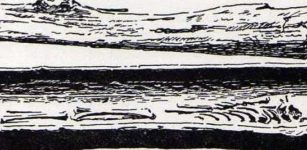 Ancient Burial Of A Princess Who Fell Off A Cliff Raises Many Questions
Archaeology | Apr 18, 2019
Ancient Burial Of A Princess Who Fell Off A Cliff Raises Many Questions
Archaeology | Apr 18, 2019 -
 On This Day In History: Remembering D-Day – On June 6, 1944
News | Jun 6, 2016
On This Day In History: Remembering D-Day – On June 6, 1944
News | Jun 6, 2016 -
 Medicine in Antiquity: From Ancient Temples To Roman Logistics
Archaeology | Apr 13, 2018
Medicine in Antiquity: From Ancient Temples To Roman Logistics
Archaeology | Apr 13, 2018 -
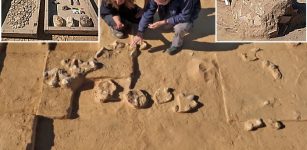 Ostrich Eggs Dated More Than 4,000 Years Discovered In Negev Desert Of Southern Israel
Archaeology | Jan 13, 2023
Ostrich Eggs Dated More Than 4,000 Years Discovered In Negev Desert Of Southern Israel
Archaeology | Jan 13, 2023 -
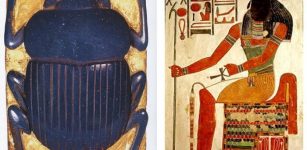 Khepri – Egyptian Progenitor God, Spirit Of Life, Resurrection And The Rising Sun
Egyptian Mythology | May 14, 2020
Khepri – Egyptian Progenitor God, Spirit Of Life, Resurrection And The Rising Sun
Egyptian Mythology | May 14, 2020 -
 Huge Ancient Hydraulic System Built By The Liangzhu Culture May Be World’s Oldest And Predate Mesopotamian Water Systems
Ancient Technology | Dec 9, 2017
Huge Ancient Hydraulic System Built By The Liangzhu Culture May Be World’s Oldest And Predate Mesopotamian Water Systems
Ancient Technology | Dec 9, 2017 -
 Mysterious 2,800-Year-Old Channel Installation Discovered In The City Of David, Jerusalem
Archaeology | Aug 30, 2023
Mysterious 2,800-Year-Old Channel Installation Discovered In The City Of David, Jerusalem
Archaeology | Aug 30, 2023 -
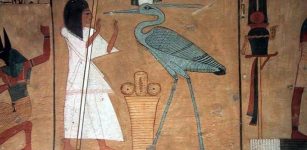 Mythical Egyptian Bennu Bird And Deity
Egyptian Mythology | Jun 5, 2016
Mythical Egyptian Bennu Bird And Deity
Egyptian Mythology | Jun 5, 2016 -
 Scientists confirm the world’s only twin asteroid strike in Sweden
Human Beginnings | Oct 1, 2015
Scientists confirm the world’s only twin asteroid strike in Sweden
Human Beginnings | Oct 1, 2015 -
 The Curse Of Chief Chocorua Who Died On The Mountain That Bears His Name
Featured Stories | Mar 9, 2019
The Curse Of Chief Chocorua Who Died On The Mountain That Bears His Name
Featured Stories | Mar 9, 2019 -
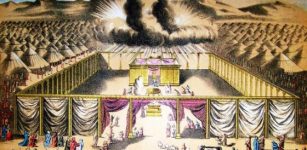 Intriguing Discovery Could Offer Proof Of The Tabernacle – Has The Dwelling Place Of God Been Located?
Archaeology | Nov 9, 2013
Intriguing Discovery Could Offer Proof Of The Tabernacle – Has The Dwelling Place Of God Been Located?
Archaeology | Nov 9, 2013

